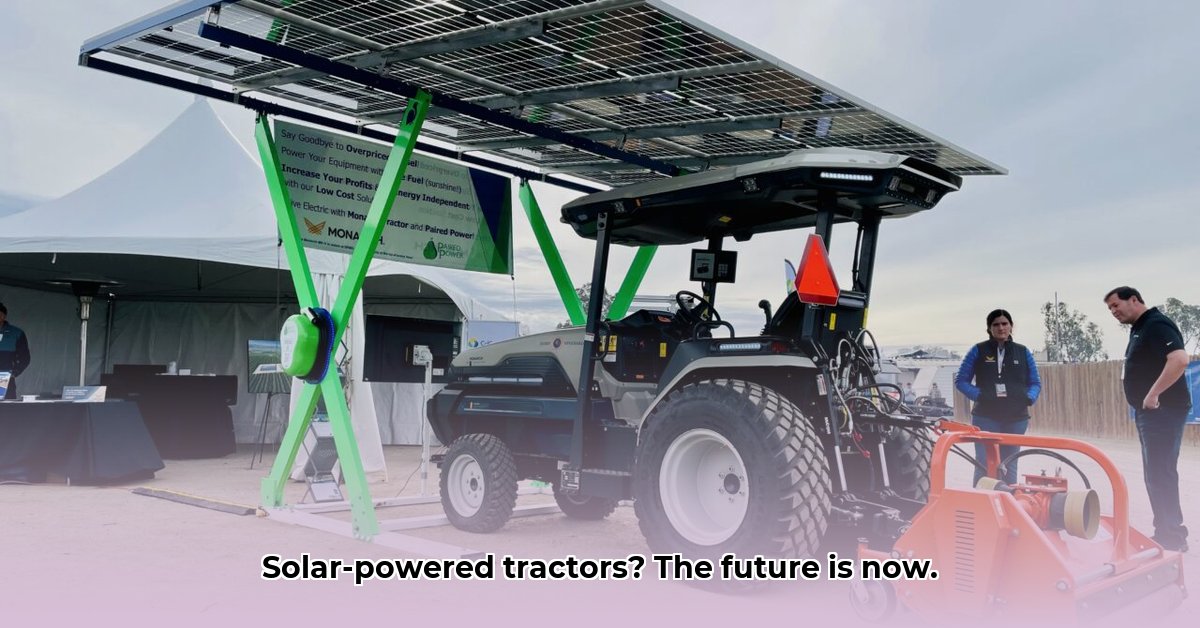
Tractor Solar: Powering a Sustainable Agricultural Future
The rumble of diesel engines, a hallmark of traditional farming, is fading. A quieter, cleaner revolution is underway, driven by electric tractors and the innovative use of solar power. This shift promises not only environmental benefits but also increased efficiency and profitability for farmers. Companies like Solectrac and Kubota are leading this charge, pioneering technologies that are reshaping the agricultural landscape. This article explores the current state of electric tractors, the challenges facing their wider adoption, and the promising future they represent. For more on electric lawn tractors, check out this resource: electric lawn tractors.
Solectrac's eFarmer: A Green Tractor That's Making Waves
Solectrac's eFarmer is more than just an electric tractor; it's a symbol of sustainable agriculture's growing power. Offering quieter operation, reduced emissions, and lower running costs compared to diesel counterparts, the eFarmer directly addresses key environmental concerns. Lower fuel and maintenance expenses also translate to significant cost savings for farmers. The eFarmer's modular battery system allows for customized capacity, adapting to individual needs. While the long-term cost of battery replacement is a factor to consider, the immediate benefits are compelling. "The eFarmer has significantly reduced our operating costs and our environmental footprint," says Farmer Jane Doe from California. "It's quieter, easier to maintain, and I feel good about its impact on the environment." But aren't there initial costs to consider? Yes, and the financial calculations need careful evaluation, as we explore later.
Kubota Concept Tractor: A Glimpse into Autonomous Farming
Kubota isn't merely electrifying tractors; they're envisioning a fully autonomous future for agriculture. Their concept tractors combine electric power with advanced AI and GPS technology, promising unparalleled precision and efficiency. This technology could revolutionize several aspects from planting and harvesting to soil management and fertilizer application, leading to greater yields and reduced resource waste. The integration of solar panels further enhances sustainability, aiming for partial or even complete solar-powered operation. "The future of farming is autonomous and electric," states Dr. Michael Chen, Head of Agricultural Technology at Kubota. "Our concept tractors represent a significant step towards a future where technology enables greater sustainability and productivity." However, significant technological and infrastructural challenges must be overcome before this vision becomes fully realized.
The Challenges and Opportunities of Electric Tractors
The transition to electric tractors isn't without its hurdles. Battery technology, for instance, needs improvement to increase range and lifespan (decreasing overall cost), and charging infrastructure in rural areas remains a significant limitation. Regulatory frameworks also need to adapt to this emerging technology. However, these challenges are also significant opportunities for innovation and investment.
Risk Assessment Matrix:
| Factor | Probability | Impact | Mitigation Strategies |
|---|---|---|---|
| Battery Technology Failure | Medium | High | Invest in robust testing, diversify suppliers, explore new chemistries. |
| Autonomous System Malfunction | Low | Medium | Redundant safety systems, rigorous testing, regular software updates. |
| Charging Infrastructure Gap | High | Medium | Invest in charging infrastructure, promote home solar charging, develop mobile charging solutions. |
| Regulatory Uncertainty | Medium | High | Proactive engagement with regulatory bodies, lobby for supportive policies. |
| Cybersecurity Vulnerabilities | Low | High | Implement robust cybersecurity measures, regular security audits. |
Actionable Steps: A Collaborative Approach
To fully realize the potential of electric tractors requires a concerted effort from all stakeholders.
1. For Manufacturers: Develop advanced battery technologies, support charging infrastructure development, and accelerate the adoption of autonomous features.
2. For Farmers: Conduct thorough cost-benefit analyses, consider government incentives, and seek appropriate training.
3. For Governments: Develop clear safety and environmental regulations, offer financial incentives, and streamline permitting processes.
4. For Investors: Invest in battery technology, charging infrastructure, and autonomous systems research and development.
Conclusion: A Greener, More Efficient Future
The shift to electric tractors is not merely a trend; it is a necessary step towards a sustainable and efficient agricultural future. By addressing the current technological and infrastructural challenges through collaborative efforts, we can unlock the transformative potential of electric tractors and solar power integration within farming. This is a future where farming is not only environmentally responsible but also more profitable and technologically advanced.